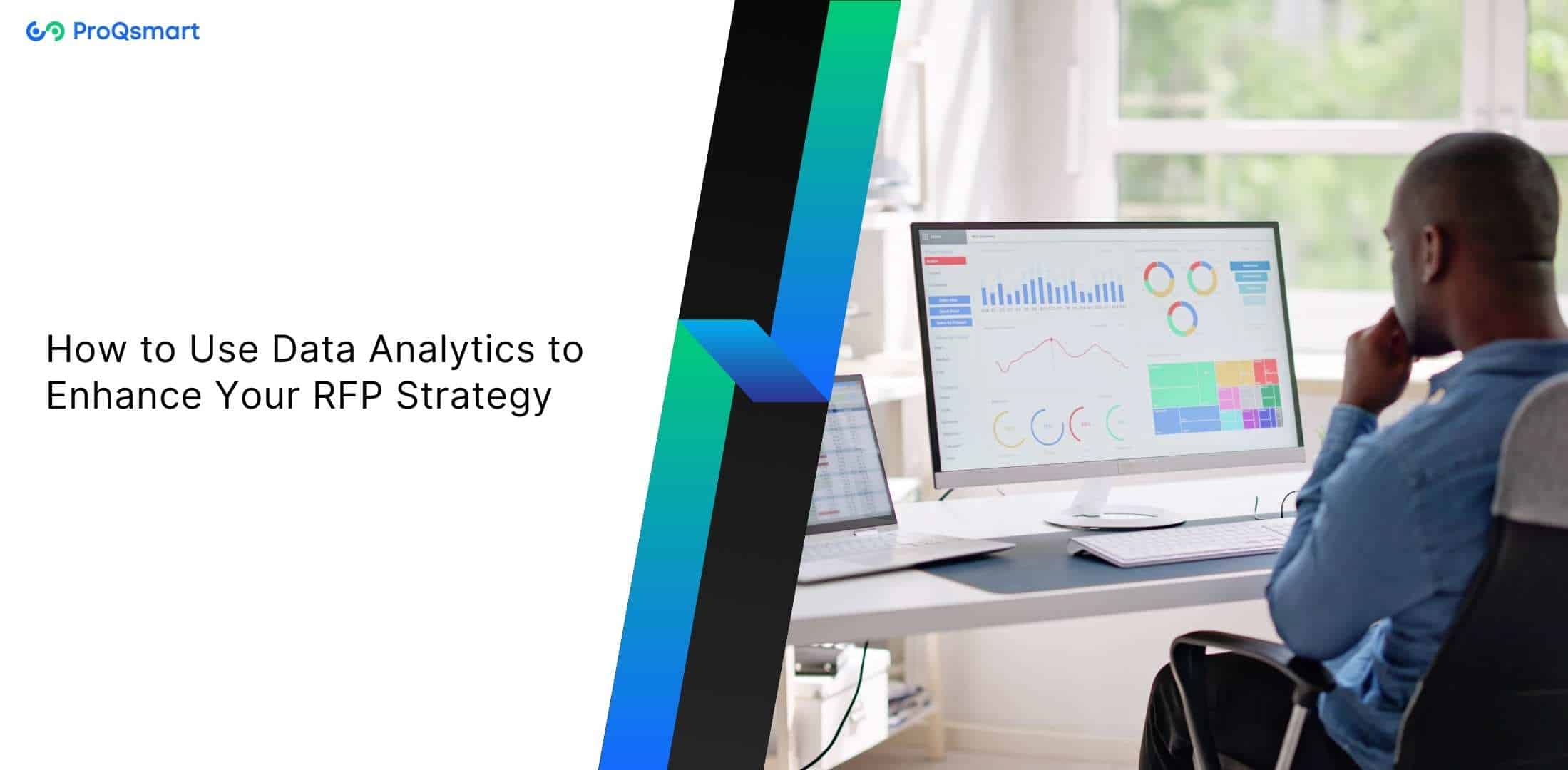As one of the oldest procurement strategies, the RFP process is the bedrock of procurement practices, enabling organizations to solicit proposals from qualified suppliers. It also serves an important function of ensuring transparency and creating a more level playing field through competitive bidding.
With an increasingly rapid business landscape and growing competition, the importance of data analytics to improve RFP efficiency and effectiveness has become crucial. With the right tools, procurement teams can use data to drive the best decisions.
This strategy improves vendor choice and ensures maximum value for their enterprises. This article takes a closer look into the potential of data-driven decision-making and how analytics can be used to focus procurement efforts better.
The Evolving RFP Landscape
The shift from traditional Request for Proposal (RFP) processes to a data-driven approach marks a significant advancement in procurement strategies. Historically, RFPs relied on outdated manual processes and subjective decision-making. Today, data analytics empowers procurement professionals with objective insights, enabling evidence-based decision-making that results in more realistic proposals.
By employing advanced analytics on historical data, organizations can forecast supplier performance more accurately. This capability not only aids in identifying the best suppliers but also enhances negotiation strategies for improved contract terms. For example, analyzing past supplier performance metrics can also reveal trends that inform negotiations, ultimately driving greater procurement efficiency.
As procurement processes become more data-driven, the expectations for RFP responses have also evolved. Buyers are now arriving at the negotiation table well prepared, armed with insights and analytics. This shift compels vendors to craft innovative and thorough RFP responses that resonate on multiple levels—beyond just pricing. In this competitive landscape, a meticulously crafted RFP response often requiring ten to forty hours of careful preparation which is vital for winning bids.
The Importance of Thorough RFP Responses
In today’s procurement environment, RFP responses must go beyond basic compliance. Buyers are looking for vendors who demonstrate a deep understanding of their needs, offer creative solutions, and provide clear value propositions. Additionally, a well-prepared RFP response not only increases the chances of winning the bid but also strengthens the vendor’s credibility and long-term relationship with the buyer.
The increasing complexity of RFP documentation reflects the current market’s demands. Overall, organizations seek solutions that provide sustainable change rather than temporary fixes. This complexity is further heightened by security concerns, especially when comparing proprietary platforms with open-source software. Vendors must also address these concerns head-on, demonstrating their ability to provide secure, reliable, and innovative solutions.
“Well-structured RFPs have a lot to recommend them. They lead to better project outcomes, better alignment with project goals, and a greater likelihood that the most qualified contractor is selected”.
Download Editable RFP Template for your industry!
Advantages of Data Analytics in RFPs
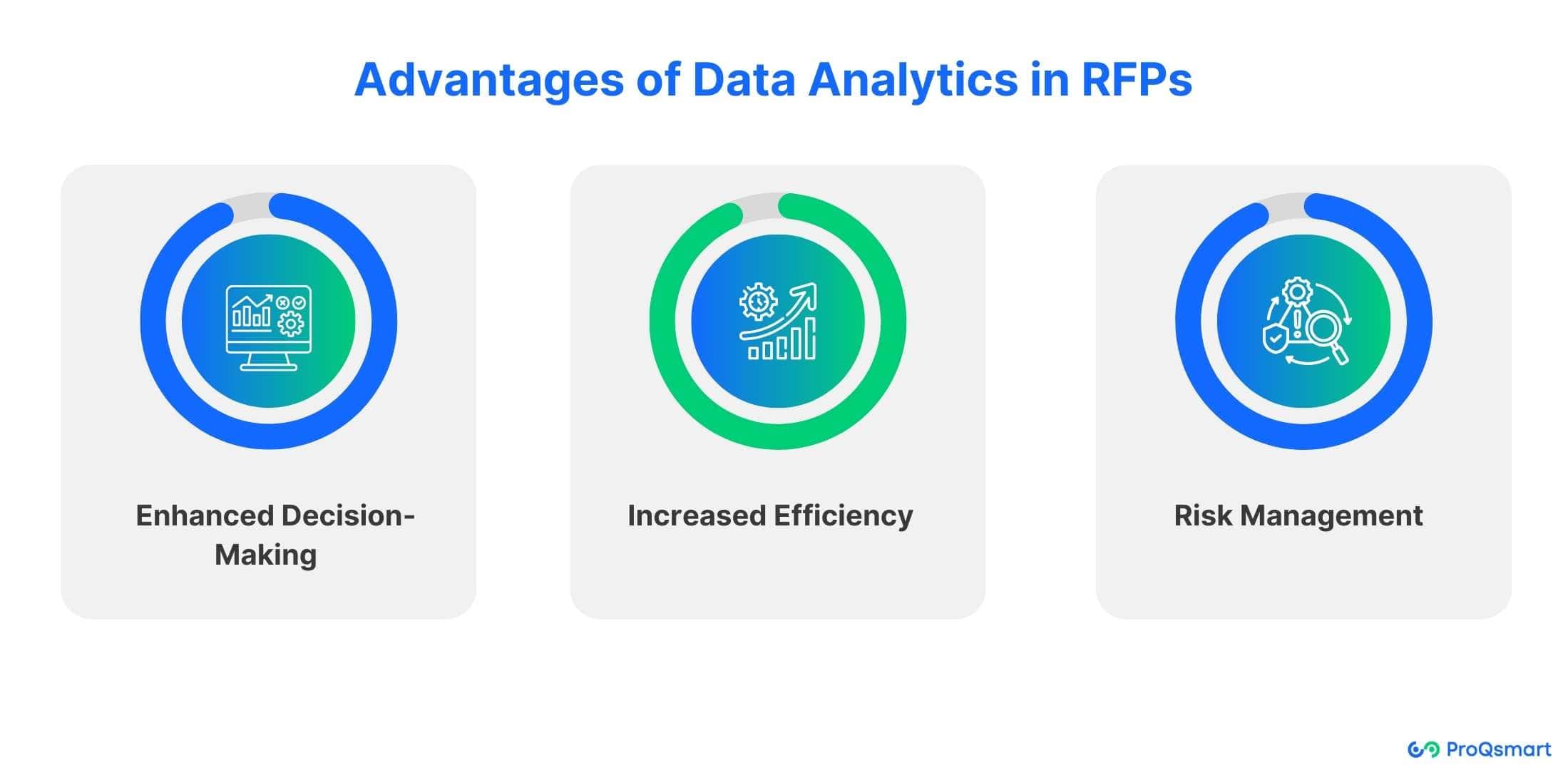
Enhanced Decision-Making
Data analytics helps more precisely define project requirements and objectives. By leveraging insights from past RFP responses, we can craft proposals that align closely with potential vendors, enhancing the likelihood of successful partnerships.
Predictive analytics takes this to the next level, helping us predict how each vendor might perform and where the greatest risks lie. Thus, this structured, data-driven approach creates a more systematic evaluation process.
Second, ” It helps make sure that vendor selection is based on strong, quantitative standards, not gut feeling”. Through predictive analytics, the ability to make evidence-based decisions goes beyond merely being reactive to being proactive as well as strategic. For instance, if data reveals that vendors from a specific region have a track record of reliability, procurement teams can indeed prioritize these suppliers in their RFPs
Increased Efficiency
Data analytics helps to speed up the RFP process by automating the process of collecting and analyzing data, eliminating much of the manual work involved. Good RFP management software or tools like ProQsmart can cut proposal prep time in half.
This allows teams to use their time and creativity to focus on the more strategic aspects of their work. Therefore, these collaborative tools significantly improve communication between proposal teams, create seamless decision-making workflows, and boost overall efficiency.
The end result is a much quicker, more streamlined RFP process that significantly saves time and money on both sides.
Risk Management
Data analytics helps identify potential risks in vendor selection by analyzing supplier performance metrics. Besides, by developing risk assessment frameworks that incorporate historical data insights, we can also proactively mitigate future procurement risks.
Therefore, this ensures compliance with regulatory requirements and enhances transparency. The ability to analyze historical data adds an extra layer of accountability, reducing the likelihood of proposal failure.
In essence, data analytics turns risk management into a proactive, rather than reactive, process.
Critical Data Points for Optimizing RFP Strategies
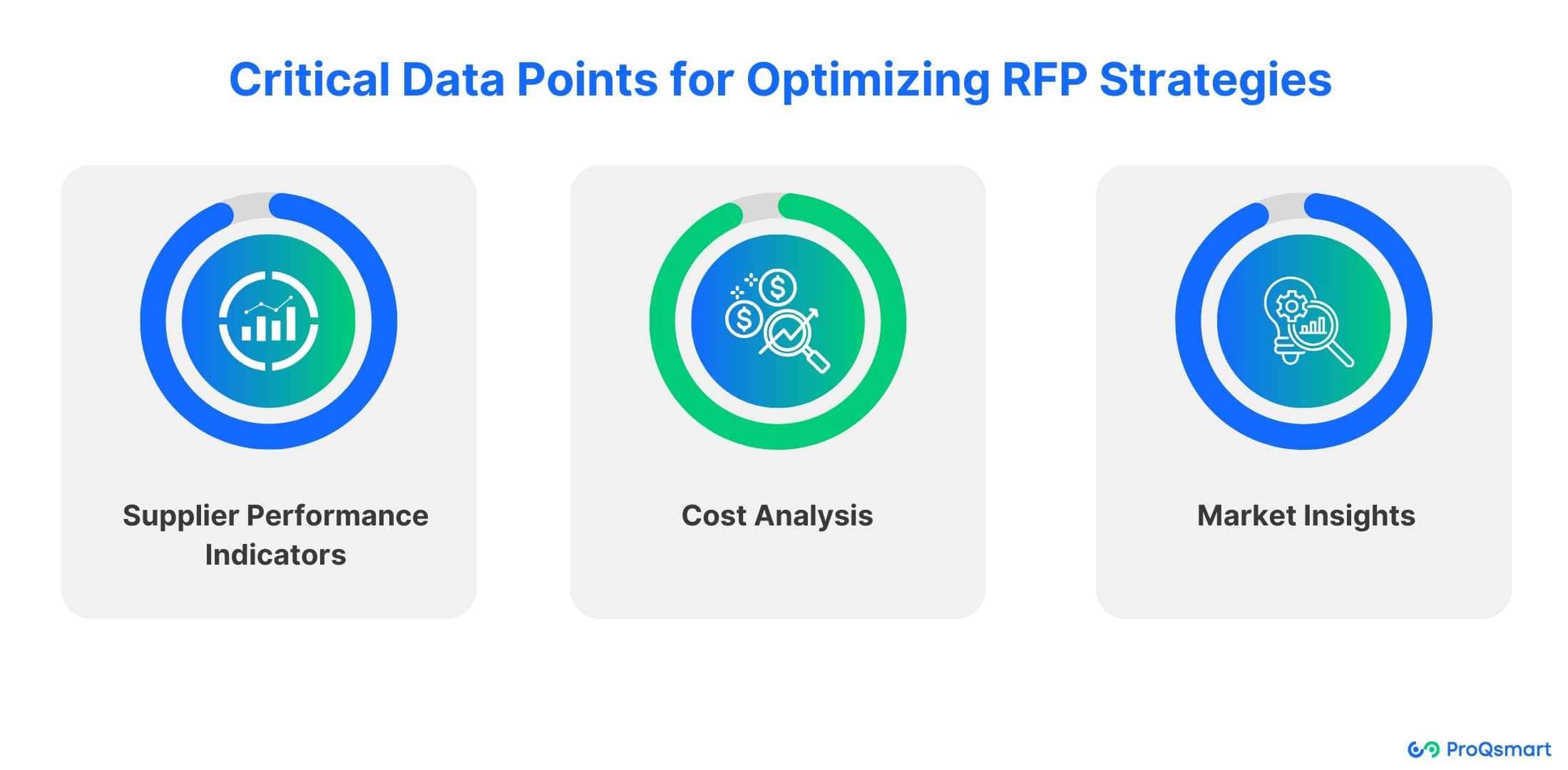
Developing a winning RFP strategy requires knowing which critical data points to focus on in order to optimize the proposal process’s effectiveness. By utilizing an RFP tool like ProQsmart , procurement professionals can significantly make better decisions by zeroing in on critical metrics and key observations. Furthermore, this strategy enables them to maximize supplier value and better match project goals with budget limits.
Supplier Performance Indicators
Smart supplier evaluation starts with knowing what key performance indicators (KPIs) matter. These metrics—delivery timeliness, quality of goods, service reliability—lay the groundwork for evaluating vendor capabilities.
This is where data analytics comes into the picture, enabling organizations to monitor and evaluate supplier performance longitudinally. For example, bench-marking vendor capabilities against well-defined benchmarks makes sure you’re evaluating everything that needs to be evaluated.
Although, by establishing feedback systems, you create a culture of continuous improvement while deepening your relationships with suppliers—which results in better RFP outcomes.
Cost Analysis
A detailed cost analysis is essential for managing budgets and avoiding surprises in RFPs. Understanding the pieces and parts of the total cost of ownership (TCO) helps ensure realistic budget proposals.
Evaluating pricing structures and vendor value propositions from various sources offers stark contrasts. Besides, having this historical cost data helps agencies understand what procurement will cost in the future, enabling them to make evidence-based decisions.
A robust cost comparison table provides additional support when selecting a vendor, helping ensure the chosen solution best fits an organization’s goals and needs. Moreover, teams that use RFP software have win rates on proposals that are significantly higher, thanks in part to improved budget proposal capabilities.
Market Insights
Identifying relevant market trends and conditions is key to creating the most effective RFP strategy. By analyzing these shifts in supply chain dynamics, we can identify opportunities to leverage these changes in vendor offerings.
Competitive analysis helps to ensure that a company is favorably positioned within the market. Leveraging external data sources significantly enhances understanding of industry benchmarks, informing strategic decisions.
Consider, for instance, companies that source 33% of their annual sales revenue via RFPs can greatly benefit from this knowledge. Conversely, consistent training and implementing RFP software are two ways to improve your market positioning and foster better collaboration.
Best Practices for Implementing Data Analytics in RFPs
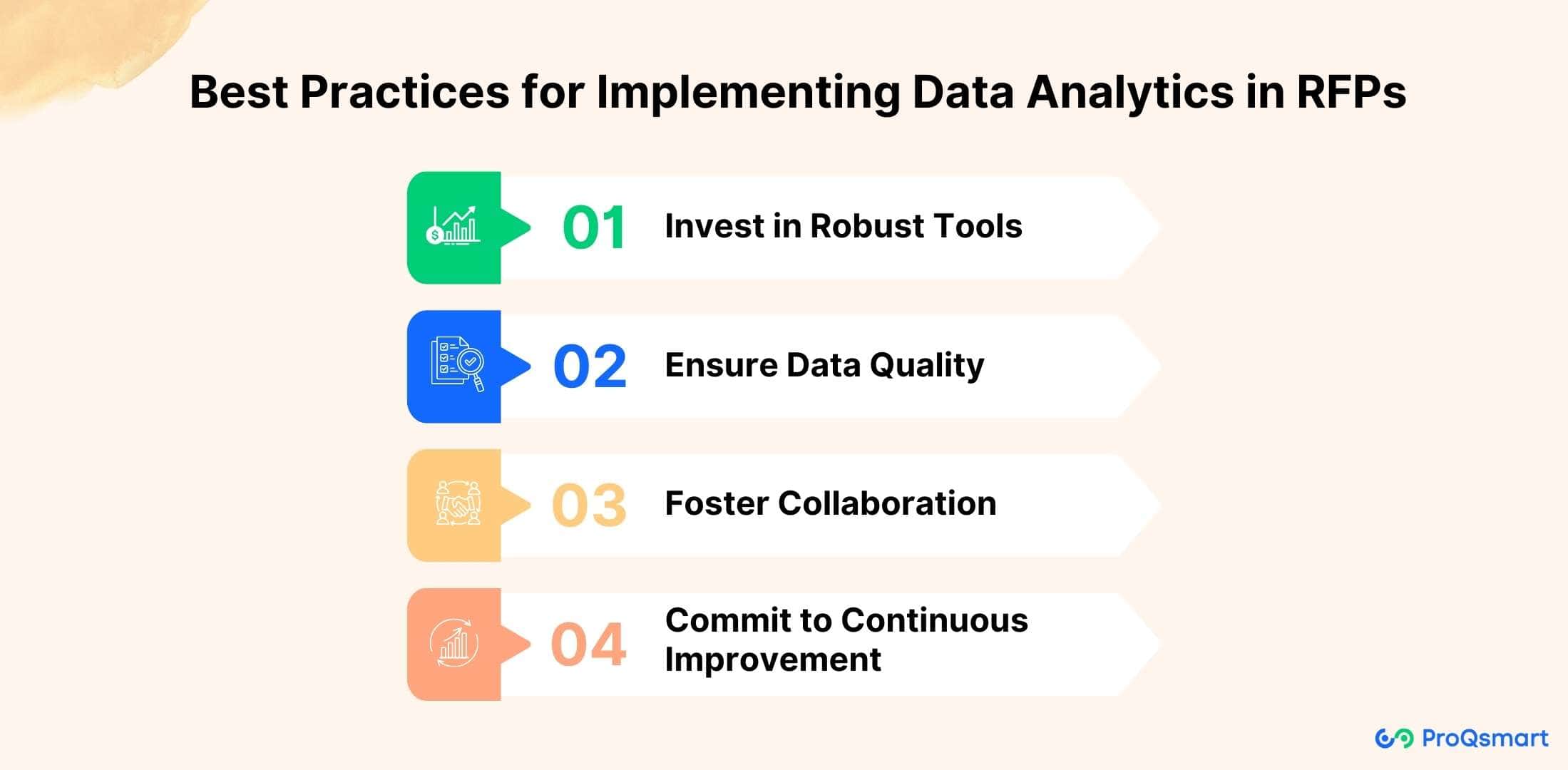
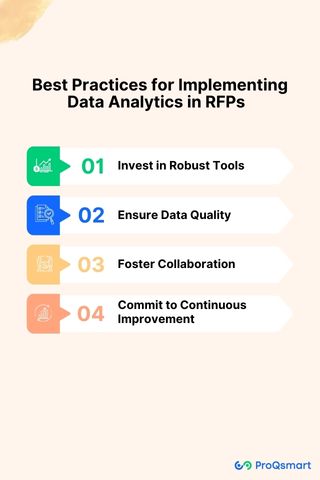
It’s important to set specific, measurable goals for integrating data analytics into your process. Know what your clients need, and don’t bother issuing an RFP. Ensuring that analytics objectives are aligned with client expectations helps lay a solid foundation for the rest of the process.
Here are some of the best practices for implementing data analytics in RFPs:
Invest in Robust Tools: Use advanced platforms like ProQsmart to automate RFP processes, analyze vendor data, and also generate actionable insights.
Ensure Data Quality: Maintain clean, accurate data through regular audits, deduplication, and validation at the source.
Foster Collaboration: Encourage cross-functional teamwork and use collaboration tools to align procurement goals with organizational objectives.
Commit to Continuous Improvement: Regularly review RFP performance, adopt emerging technologies, and train teams to stay ahead of industry trends.
Invest in Robust Tools
Choosing the best analytics tools starts with determining what features are essential to having a robust RFP management. Platforms such as ProQsmart provide dashboards and reporting capabilities, making it simple to let RFP data roll up and track over time.
Evaluating these platforms based on your organizational needs is key. Scalability is another important aspect to consider, making sure the tools can accommodate any potential increase in RFP volume down the line.
Eventually, providing training on these tools for procurement teams will ensure they are used most effectively and optimally to drive organizations toward their goals.
Ensure Data Quality
Keeping quality data means having clear data cleansing practices in place to eliminate false information. Having procedures in place for periodic data audits explicitly ensures that standards are maintained.
Holding procurement professionals accountable for their use of data means that the insights drawn will be trustworthy. Incorporating various data sources, significantly enhances the depth of analytics, allowing for a broader perspective.
Here are best practices to ensure your data remains clean and reliable:
Establish Clear Standards: Define consistent formats for data entry, such as standardized date formats, currency types, and vendor naming conventions. Create a data dictionary to document these standards for reference.
Conduct Regular Audits: Perform periodic data audits to identify and correct inaccuracies, duplicates, or outdated information. Use automated tools to flag inconsistencies and ensure data integrity.
Eliminate Duplicates: Implement deduplication processes to remove redundant records. Leverage tools with fuzzy matching capabilities to detect and merge near-duplicate entries.
Validate at the Source: Enforce validation rules during data entry, such as mandatory fields and format checks. Integrate with trusted external sources to verify vendor credentials automatically or compliance status.
Automate Cleansing: Leverage AI and machine learning tools to automate error detection and correction. Platforms like ProQsmart can streamline this process, ensuring high-quality data for analytics.
Foster Collaboration
Encouraging cross-departmental collaboration not only improves understanding, but it makes creating RFP strategies more effective. Additionally, adopting collaborative online platforms reduces email, centralizes communication, and also invites all stakeholders to the decision-making table.
Engaging vendors early in the RFP process to solicit their valuable insights and establishing feedback loops creates a culture of continuous improvement.
Commit to Continuous Improvement
To ensure your RFP process stays efficient and aligned with industry best practices, focus on these actionable steps:
Leverage AI-powered analytics platforms like ProQsmart to analyze past performance, identify trends, and optimize strategies.
Track key metrics such as cost savings, vendor response times, and compliance rates to refine your approach.
Invest in training programs to upskill your team in data analytics, procurement best practices, and emerging technologies.
Encourage knowledge sharing by having team members document and discuss lessons learned from past RFPs.
Stay updated on industry trends through publications, webinars, and forums, and benchmark your processes against global standards.
Adopt cutting-edge practices like AI-driven vendor evaluation and blockchain for enhanced transparency and efficiency.
Automate workflows using RFP tools to reduce manual tasks, minimize errors, and speed up cycles.
Use pre-built templates to standardize processes while allowing flexibility for customization.
Monitor progress with real-time dashboards to track RFP status, vendor performance, and compliance.
Conduct post-RFP reviews to evaluate successes and challenges, applying insights to future projects.
Future Trends in Data Analytics for RFP Processes
“Machine learning and AI innovations will completely transform the process of supplier evaluation within RFPs.”
In addition, these technologies will revolutionize risk management practices. Combined with the power of AI, they allow us to predict supplier behavior with greater accuracy than ever before, providing a more accurate view of risks and opportunities in the proposal process.
To take just one example, AI tools can sift through historical performance metrics and current market trends, helping us make smarter, data-driven decisions. AI enhances our RFP writing abilities. AI works best when combined with the human element. It adds to what we’re able to do without subtracting from our special sauce.
One of the other trends revolutionizing the RFP process is the integration of various data sources. With a rich data set that merges ERP and CRM system data, you can take a 360-degree look at a supplier’s performance. This integration further ensures a more efficient procurement process that is purposefully aligned to achieve specific project goals.
Platforms such as ProQsmart also streamline the bidding process and help organize documentation. Not only do they encourage collaboration in real-time, but they also help maintain compliance and transparency throughout the project management workflow.
As regulatory requirements change, being able to stay agile is key to pivoting as new rules emerge. With 84% of respondents viewing it as a driver for improved procurement performance, digitalization highlights the need for agility in this exciting yet challenging new reality.
Aspect | Without Data Analytics | With Data Analytics |
Supplier Risk Management | Manual risk assessment; limited ability to predict supplier behavior or market disruptions. | AI predicts supplier behavior; identifies risks and opportunities in real time. |
Vendor Evaluation | Subjective, manual evaluation; limited insights beyond price. | AI scores vendors objectively; integrates ERP/CRM data for a 360-degree performance view. |
RFP Writing Efficiency | Manual creation; inconsistent formats; delays due to poor collaboration. | Automated RFP creation; real-time collaboration; consistent, error-free documentation. |
Cost Optimization | Limited visibility into pricing trends; higher procurement costs. | Predictive analytics identifies cost-saving opportunities; optimizes pricing strategies. |
Compliance & Transparency | Manual tracking; lack of audit trails; slow adaptation to regulatory changes. | Automated compliance checks; detailed audit trails; agile adaptation to new regulations. |
Conclusion
Incorporating data analytics into the RFP process can significantly transform procurement strategies by delivering actionable intelligence that empowers informed decision-making. Besides, by focusing on critical data points, procurement professionals can enhance their chances of success, as real-time analytics improve accuracy in vendor evaluation and selection.
ProQsmart exemplifies this approach by using ai-powered advanced analytics to provide visibility into spending patterns, supplier performance, and procurement metrics. Its customizable dashboards allow stakeholders to access relevant insights quickly, while predictive analytics helps forecast trends and mitigate risks.
Furthermore, automation and AI streamline operations, reducing manual efforts and ensuring decisions are based on comprehensive data. As organizations embrace these innovative strategies, they position themselves to navigate emerging markets effectively and achieve sustainable growth. Now is the time to integrate data analytics into the fabric of procurement processes to capitalize on the opportunities this transformative approach offers. Book a demo with ProQsmart today!

